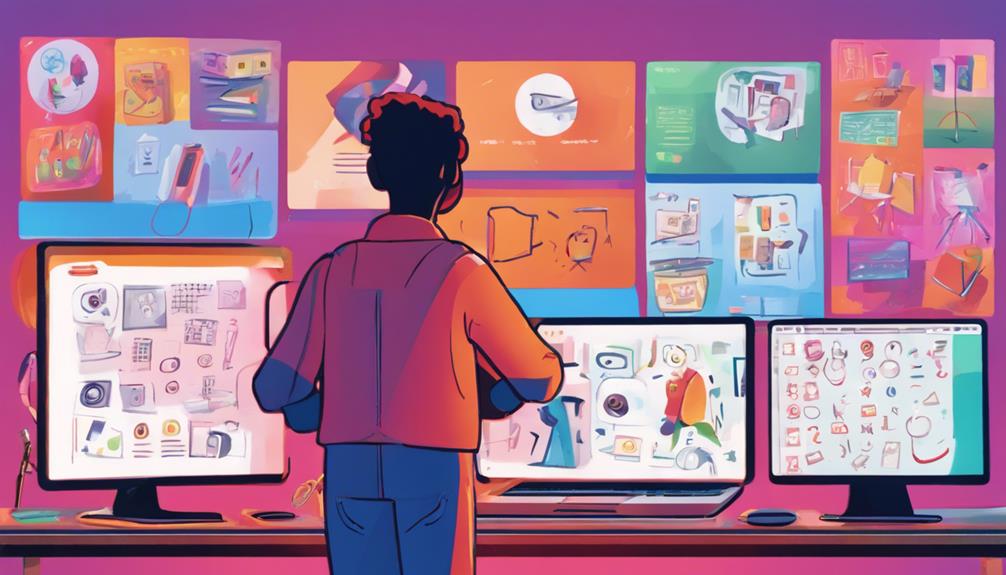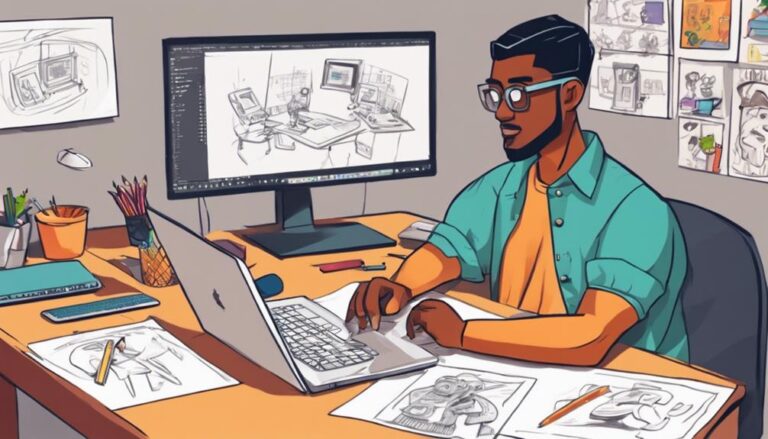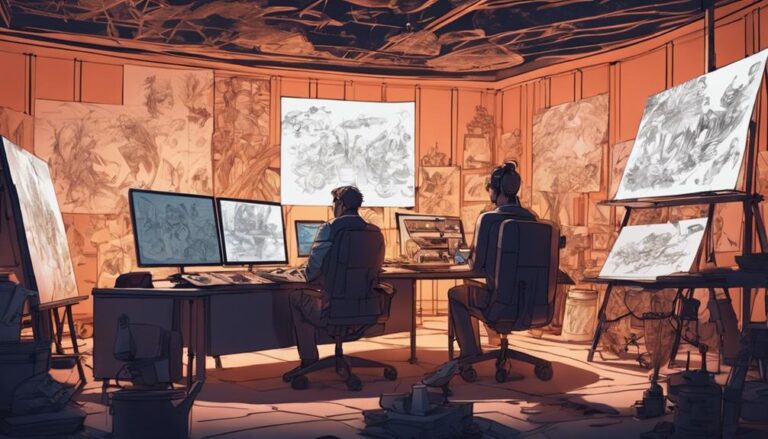How to Choose Animation Studios for Educational Video Production
When choosing an animation studio for educational video production, start by defining your project's educational goals, including identifying key concepts, determining primary learning objectives, and ensuring SMART goals. Assess the studio's expertise levels, evaluating industry knowledge, technical skills, and familiarity with trends and best practices. Review their portfolio quality, looking for depth, variety, consistency, and ability to convey complex information. Verify their technical capabilities and evaluate their reputation by checking client testimonials and industry experience. By considering these factors, you'll be able to find a studio that meets your needs and helps you effectively reach your target audience.
Key Takeaways
- Define clear educational goals and SMART objectives to guide the animation studio selection process.
- Assess studio expertise levels, technical skills, and familiarity with trends and best practices in educational animation.
- Evaluate studio portfolios for quality, depth, variety, and ability to convey complex information effectively.
- Research client testimonials, reviews, and ratings to gauge a studio's reputation and industry experience.
- Compare studio pricing models, ensure timely delivery guarantees, and evaluate communication channels and support.
Define Your Educational Goals
As you begin considering animation studios, it's crucial to define your educational goals upfront.
This step is essential to ensure that the animation studio you choose can meet your specific needs and deliver content that aligns with your learning objectives. Your goals should be specific, measurable, achievable, relevant, and time-bound (SMART) to facilitate clear communication with potential studios.
To define your educational goals, start by identifying the key concepts you want to convey through the animation.
What're the primary learning objectives you want to achieve? What skills or knowledge do you want to impart to your audience? Be specific about the desired outcomes, such as increased understanding, improved retention, or enhanced engagement.
Next, assess the content alignment requirements for your animation.
Will the content need to meet specific curriculum standards or adhere to particular formatting guidelines? Ensure that the animation studio you choose can accommodate these requirements and deliver content that's both engaging and informative.
Assess Studio Expertise Levels
To assess studio expertise levels, you'll need to evaluate the studio's industry knowledge base, including their understanding of current trends, technologies, and best practices in animation.
You'll also want to examine the technical skill levels of their team members, including their proficiency in specific software, tools, and techniques.
Industry Knowledge Base
Assessing a studio's expertise levels involves evaluating their industry knowledge base, which encompasses the collective skills, experience, and understanding of animation techniques, software, and best practices. When evaluating a studio's industry knowledge base, you should consider their familiarity with current industry insights and animation trends. This can be gauged by reviewing their portfolio, website, and social media platforms to see if they're actively engaged with the latest developments in the field.
| Industry Knowledge | Key Indicators | Desirable Outcomes |
|---|---|---|
| Familiarity with industry trends | Regularly updated blog, engagement with industry events | Ability to apply current trends to your project |
| Understanding of animation techniques | Showcase of diverse animation styles, willingness to experiment | Effective use of animation techniques to convey complex information |
| Knowledge of best practices | Adherence to industry standards, use of project management tools | Efficient project workflow, high-quality final product |
Technical Skill Levels
When evaluating a studio's technical skill levels, you'll want to scrutinize their proficiency in utilizing various software, tools, and technologies to produce high-quality animations.
This includes assessing their software proficiency in industry-standard tools such as Blender, Adobe Animate, or Toon Boom Harmony.
You'll also want to look at their team expertise in areas like 2D and 3D animation, motion graphics, and visual effects.
Assess the studio's ability to work with different file formats, resolutions, and frame rates.
Check if they can handle complex animations, such as those requiring simulations or physics-based effects.
It's also essential to evaluate their experience with different video editing software, like Avid Media Composer, Adobe Premiere Pro, or Final Cut Pro.
Review the studio's technical specifications, including their computer hardware, software versions, and network infrastructure.
Ensure they've the necessary equipment and expertise to deliver high-quality animations on time.
Evaluate Animation Style Options
Evaluating animation style options is a crucial step in selecting an animation studio that aligns with your project's goals.
When choosing an animation studio for educational video production, you want to ensure that their style complements your content and resonates with your target audience.
A studio's visual flair and artistic vision can significantly impact the overall effectiveness of your educational video.
To gauge a studio's animation style options, consider the following:
- 2D vs. 3D animation: Will a 2D or 3D animation style better suit your content and engage your audience?
- Realistic vs. stylized animation: Do you prefer a realistic or stylized approach to animation, and can the studio deliver on your preference?
- Motion graphics capabilities: Can the studio effectively incorporate motion graphics to enhance your video's visual appeal and convey complex information?
Check Studio Portfolio Quality
When checking a studio's portfolio quality, you should look for depth and variety in their projects, as well as consistency in style and quality.
The studio's past work should demonstrate their ability to produce high-quality animations that align with your project's needs.
Portfolio Depth and Variety
A portfolio is often the best representation of an animation studio's capabilities.
When reviewing a studio's portfolio, you should look for depth and variety to gauge their artistic range and visual diversity. A diverse portfolio indicates that the studio can adapt to different styles, mediums, and subjects, which is crucial for educational video production.
You want a studio that can effectively convey complex information in an engaging manner.
- Variety of animation styles: Can they produce both 2D and 3D animations? Are they proficient in stop-motion or motion graphics?
- Range of subject matter: Have they worked on projects related to science, history, or technology? Can they tackle complex topics in an engaging way?
- Different project scales: Have they handled large-scale projects or small, short-form videos? Can they adapt to your project's specific needs?
Style Consistency and Quality
| Quality Aspect | Good Quality | Poor Quality |
|---|---|---|
| Color Palette | Consistent color scheme, well-balanced contrast | Inconsistent colors, poor contrast |
| Character Design | Uniform character design, attention to detail | Inconsistent character design, lack of detail |
| Animation Smoothness | Smooth motion, fluid transitions | Choppy motion, abrupt transitions |
| Background Design | Well-designed backgrounds, attention to detail | Poorly designed backgrounds, lack of detail |
| Visual Effects | Effective use of visual effects, well-integrated | Overuse of visual effects, poorly integrated |
When evaluating a studio's portfolio, look for these quality aspects and assess whether they demonstrate a consistent style. A studio with a strong style consistency and high-quality visuals will be better equipped to deliver a professional-looking educational video that meets your expectations.
Relevant Past Projects
As you review an animation studio's portfolio, look for relevant past projects that demonstrate their ability to deliver high-quality educational content similar to your project.
Checking a studio's portfolio quality is crucial in determining whether they can meet your needs. When evaluating a studio's portfolio, pay attention to project highlights and case studies that showcase their experience in creating educational content.
This will give you an idea of their strengths and weaknesses.
- Relevant industry experience: Has the studio worked with clients in the education sector or created content similar to yours?
- Project scope and complexity: Can the studio handle projects of similar scope and complexity to yours?
- Style and tone consistency: Does the studio's portfolio demonstrate consistency in style and tone, and can they adapt to your brand's voice and aesthetic?
Review Client Testimonials Online
Numerous client testimonials are available online, offering valuable insights into an animation studio's strengths and weaknesses.
When reviewing these testimonials, consider the client's background and the specifics of their project. This context helps you understand the relevance of their experience to your own project needs.
You can find online reviews on a studio's website, social media, or review platforms like Clutch, GoodFirms, or Google Reviews.
Look for specific examples of successful collaborations, challenges overcome, and the quality of the final product. Pay attention to the client's feedback on the studio's communication, timeliness, and budget management.
When evaluating online reviews, be cautious of biased or fake testimonials. Check if the reviews are verified and if they provide specific details about the project.
A balanced review that discusses both the positives and negatives can be a good indication of a genuine testimonial. Use this information to create a comprehensive picture of the animation studio's capabilities and potential fit for your educational video production project.
Compare Studio Pricing Models
When evaluating potential animation studios, you'll need to compare their pricing models to determine which one best fits your budget and project requirements.
Two common pricing models used by studios are per hour pricing and fixed project cost, each with its own set of advantages and disadvantages.
You should carefully consider these models to ensure you understand how costs will be incurred and can plan accordingly.
Per Hour Pricing
Per hour pricing is often the go-to model for animation studios, allowing clients to budget for specific project needs.
This model can be budget-friendly, as you only pay for the actual time spent on your project. However, the hourly rate can vary significantly between studios, making it essential to compare prices and services.
When evaluating animation studios based on their hourly rate, consider the following factors:
- Expertise: More experienced studios may charge higher hourly rates, but their expertise can lead to more efficient production and better quality.
- Services included: Some studios may include additional services, such as project management or scriptwriting, in their hourly rate, while others may charge extra.
- Location: Studios based in countries with a lower cost of living may offer more competitive hourly rates.
To make the most of the per hour pricing model, it's crucial to have a clear understanding of your project's scope and the studio's pricing structure.
This will help you create a realistic budget and ensure that your project stays on track.
Fixed Project Cost
Comparing studio pricing models reveals that fixed project cost is an alternative to hourly pricing, offering you a more predictable budget.
When you opt for a fixed project cost, the animation studio agrees to complete your educational video production within a set budget, eliminating the risk of cost overruns. This pricing model is ideal for clients with budget constraints, as it provides cost transparency and allows you to plan your expenses more effectively.
To choose a studio with a fixed project cost model, you need to clearly define your project requirements and scope.
This ensures that the studio provides a comprehensive quote that includes all the necessary elements, such as scriptwriting, storyboard development, animation, and voiceover recording. When reviewing the quote, make sure to check for any exclusions or assumptions that could impact the final cost.
A fixed project cost model can be beneficial for both parties, as it incentivizes the studio to work efficiently and meet the agreed-upon deadlines.
Look for Relevant Industry Experience
When evaluating a studio's industry experience, consider the following factors:
- Relevant project portfolio: Have they worked on similar projects in the educational sector?
- Client testimonials: Do their previous clients in the educational sector speak highly of their work?
- Awards and recognition: Have they received awards or recognition for their work in educational video production?
A studio with relevant industry experience can help you navigate the complexities of creating effective educational content.
They can provide valuable insights and suggestions to enhance the learning experience.
Assess Communication and Support
Evaluate the studio's communication channels, such as email, phone, or project management software.
Ensure they're transparent and responsive to your inquiries. Ask about their feedback loops and how they'll keep you informed about project progress.
A studio that can provide regular updates and address your concerns promptly is more likely to deliver a successful project.
You should also ask about their support after project completion, including any revisions or maintenance requirements.
A studio that offers ongoing support can help ensure your educational video remains effective over time.
Check Technical Capabilities Match
A mismatch between your project's technical requirements and the studio's capabilities can lead to frustrating delays, increased costs, or even project abandonment.
When choosing an animation studio for educational video production, it's crucial to ensure their technical capabilities match your project's needs.
To verify this match, ask about the studio's:
1. Software compatibility: Are they proficient in your preferred software or can they adapt to it?
Ensure their software is compatible with your existing workflows and tools.
2. Equipment investments: Have they invested in the necessary equipment to support your project, such as high-performance computers or 4K resolution capabilities?
3. File format support: Can they handle your desired file formats, including video codecs and resolutions?
Ensure Timely Delivery Guarantees
At least 80% of projects experience delays due to unrealistic timelines or poor project management. When choosing an animation studio for educational video production, you must ensure they provide timely delivery guarantees. This involves understanding their project management process and delivery schedules.
| Project Milestones | Expected Completion Time | Delivery Guarantees |
|---|---|---|
| Script Development | 3-5 days | Guaranteed review within 24 hours |
| Storyboarding | 5-7 days | Delivery within 3 days of approval |
| Animation Production | 4-6 weeks | Regular progress updates |
| Final Review and Delivery | 1-2 weeks | Guaranteed delivery within 1 week of final approval |
When evaluating an animation studio's delivery guarantees, consider the following factors:
- Clear project milestones and timelines
- Realistic expectations for completion times
- Regular progress updates and check-ins
- A clear understanding of their delivery process and what you can expect
Frequently Asked Questions
Can I Customize the Animation Style to Fit My Brand?
You can customize the animation style to fit your brand by defining your brand identity and visual consistency guidelines, then collaborating with the studio to ensure their style aligns with your existing visual elements.
Do Studios Offer Educational Video Production Packages?
When selecting a studio, you'll find many offer package options with customized pricing to fit your needs. These packages often include pre-defined services, revisions, and delivery timelines, allowing you to budget and plan your project effectively.
Are Revisions Included in the Initial Production Cost?
When evaluating production costs, you should ask if revisions are included in the initial price. Look for studios offering cost transparency and budget flexibility to ensure you're not surprised by additional fees for requested changes.
How Long Does the Average Production Project Take?
You'll typically spend 6-12 weeks on a project, divided into production phases like concept development, storyboarding, and finalization. The project timeline may vary depending on the animation style, complexity, and your studio's workload.
Can I Request a Free Trial or Sample Animation?
You can request a free trial or sample animation to test drive the quality of an animation studio's work. Review their animation portfolio to ensure their style aligns with your educational video production needs.
Conclusion
When choosing an animation studio for educational video production, consider your goals, studio expertise, animation style, portfolio quality, client testimonials, industry experience, communication, technical capabilities, and delivery guarantees. Ensure the studio aligns with your objectives and can effectively convey complex information. By evaluating these factors, you'll be able to select a studio that meets your needs and produces high-quality educational videos. This careful selection process will save you time and resources in the long run.







